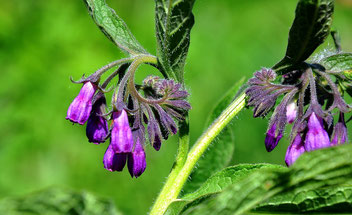Comfrey
Symphyti radix

Comfrey (Symphyti radix) root extracts have anti-inflammatory, wound-healing and antibacterial properties. Comfrey speeds cell growth, and in traditional medicine was used to support bone healing.
The plant contains pyrrolizidine alkaloids, which are toxic in high doses and may have carcinogenic properties, so home-brewed comfrey extracts should never be used on open wounds. Even on whole skin, the use of such extracts should be limited to no more than six weeks per year.
However, there are some chemically processed extracts, which have been cleansed of the pyrrolizidine alkaloids and are thus safer to use.
Links
Comfrey in Modern Herbal Medicine:
- Cochrane found that comfrey extract gel probably improves pain more than placebo in patient suffering from osteoarthritis.
- The European Scientific Cooperative on Phytotherapy (ESCOP) found that comfrey root extracts is effective in patients with sprained ankles, painful joint complaints and osteoarthritis of the knee. ESCOP also confirmes that comfrey can be used to support wound healing, provided the pyrrolizidine alkaloids have been removed.
Comfrey in Fiction:
- In her story "Silver" in the short story collection Shifting Shadows, Patricia Briggs mentions comfrey as one of the ingredients of a salve the werewolf-cum-physician Samuel uses to treat a Fae woman's wounds.
Blog Posts
Treating Battle Wounds: Honey, Comfrey and Yarrow

Today's post will look at the treatment of battle wounds: A topic that often comes up in fantasy novels, and one that our average fictional healer or herbwoman has to deal with on a regular basis.
Nature provides a number of remedies that a healer can use to treat wounds. Some examples for such natural medicines are honey, comfrey and yarrow.
In the following snippet from Patricia Brigg's novelette "Silver" (from the short story collection "Shifting Shadows"), werewolf-cum-healer Samuel uses a salve made from these ingredients to treat a grievously injured fae woman:
The woman didn't stir beyond a flutter of her eyelashes when I stitched up a particularly nasty tear over her hip. The worst hurt was a gash in her thigh that was too old to stitch. It would
likely cause her trouble long after it healed. I covered it with a salve of fat, honey, yarrow and comfrey that the little fae, who had shyly introduced herself as Haida, had brought back when I
asked her if she had such a thing.
*** Please note: This blog is not intended as medical advice. ***
Do not try this at home.
(Or at least, don't use any of the remedies described here this without consulting your physician first.)
